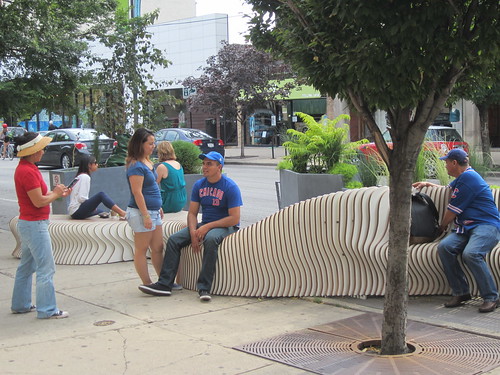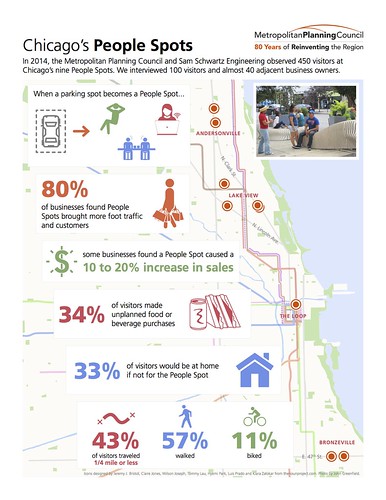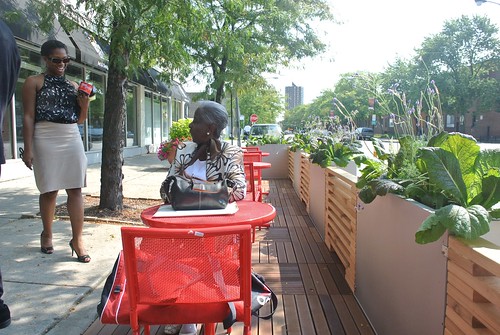From a quick glance at a People Spot mini park filled with people enjoying the weather on a gorgeous afternoon, it may seem obvious that the extra foot traffic is providing a boost to nearby businesses. A recent study by the Metropolitan Planning Council attempted to quantify this economic benefit, and found that these parklets do, in fact, provide a significant shot in the arm for local retail.
Chicago’s People Spots repurpose asphalt in a street's curb lane to use it as public space for residents, rather than parking space for private cars. These are facilitated by the Chicago Department of Transportation and paid for by local businesses. They consist of a seating area on a platform in the street, surrounded by planters, which shelter users from car traffic.
The design can range from a typical sidewalk café-style layout, with tables and chairs, to the imaginative free-form fixtures at the People Spot at Southport and Addison in Lakeview, which vaguely resemble a whale’s skeleton. Any displaced metered parking is relocated to another part of the ward. The parklets are removed each year by November 1, when the space reverts to car parking until the spring.
In July and August of this year, MPC and Sam Schwartz Engineering observed activity from 9 a.m. to 7 p.m. on weekdays at Chicago’s eight People Spots in Bronzeville, Lakeview, and Andersonville, as well as the People Plaza seating area in the median of State and Lake in the Loop. Unfortunately, a People Spot that was proposed this year for the corner of Dearborn and Adams, outside the MPC offices, was kyboshed due to insurance issues. The researchers observed about 450 parklet users, and interviewed more than 100 of them, as well as some 40 business owners.
About 80 percent of the merchants surveyed said that the People Spots increased foot traffic on their block, and helped bring customers to their establishments. Some credited the parklets with contributing to a 10 to 20 percent increase in sales since they were installed. For example, owner Michael Salvatore of Heritage Bicycles, 2959 North Lincoln, said the café-style parklet in front of his store is “Instagram Heaven,” which encourages customers to spread the word about his cycles and coffee via social media.
Dane Redway, manager of Akira clothing store, 5228 North Clark, said the adjacent People Spot serves as a “town square,” where “people sit and stare at the storefront windows.” Even if they don’t make purchases at the time, he thinks those parklet users are more likely to come back and shop in the future.
The study found that 93 percent of parklet users and merchants felt that the facilities created a more positive vibe on the retail strips. In some cases, the spots have been used for community events. Bronzeville’s Quad Communities Development Corporation organized a jazz concert, as well as an arts showcase featuring tapdancers, at the neighborhood’s two People Spots at 643 and 918 East 47th Street. The Lincoln and Andersonville parklets hosted a 50-person potluck and a brass band concert, respectively.
73 percent of People Spot users said that, if they weren’t hanging out in the spaces, they would probably be at home, and 34 percent of them made spontaneous food or beverage purchases, the study found. 43 percent of respondents said they traveled two blocks or less to get there. 57 percent of them walked to the parklets, while another 11 percent got there by bike.
It may seem obvious to Streetsblog readers that using public space to provide an amenity for residents and shoppers, rather than to warehouse private property, is beneficial for nearby businesses. However, in the past, some merchants have balked at the notion of using any curbside parking spaces for People Spots. The MPC study should be a useful tool for convincing skeptical business owners that a new parklet will be good for their bottom line.







